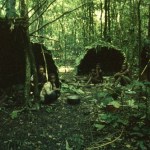Pygmies
It has been said that our most distant primate ancestors, the mammal that gave rise to early primates but itself wasn't quite a primate, was most like the Asian tree shrew, which is neither a shrew nor does it live in trees. This is, of course, untrue. When the average American sees a shrew native to the new world scurrying past, he or she usually thinks of it as a form of mouse. Which it isn't. (In fact, there are no "mice" native to the new world, but even if we give our hypothetical observer the concept of "rodent" as in "eeek, a rodent" the shrew is not that either.) If you spend any…
An Efe forest camp is usually dark and depending on the time of day, dripping from current or recent rain. The Efe live in dome shaped huts which may be more or less complete. A half dome might be a hut that was built quickly, or it might be a hut that was built more openly because it has been hot or it might be only a half dome to allow easier access in and out of the hut by children or individuals with injury or infirmity. A fully domed hut, with a small opening, keeps in more smoke (a fire is often kept in the hut) but it also keeps in the heat and keeps out the rain. So a rainy…
Today, I took out the trash. I may or may not have taken the trash out last week, but I can tell you that the last time I did take it out, whenever it was, I had to drag the trash barrel across ice. Yesterday I went to the gym without a coat or jacket. That made me have to decide if I wanted to go to the locker room to stow the contents of my pockets (car keys, etc.) or just keep those things in my pocket. The grass outside is green. We expect snow on Friday.
Where I grew up, in what is now known among gardeners and cooperative extension agents as Zone 5b (though a short drive from a…
In which I explore the interface between the Jungian Subconscious and my own primordial anguish.
The blocked end tube pipe is a touchstone to the shamanistic world of the people we call the Hopewell. Similar artifacts are found elsewhere in the world, but the Adena-Hopewell cultural complex (dating to approximately a thousand year plus long period centering on "Zero" AD/BC/b.c.e.) has more of them than your average archaeological culture. The blocked end tube is made of soapstone, and is a cylinder almost hollowed out but with a wall of stone left intact so nothing physical can actually…
At the beginning of the 20th century, a traveler in Central Africa made mention of some strange people that he had come across. He was traveling among regular, run-of-the-mill natives...probably Bantu-speaking people living in scattered villages and farming for their food. But along the way, strange people came out of the forest. These strange people had sloping foreheads; they were short of stature, bow-legged and otherwise misshapen. They also clearly were, in the eyes of the traveler, of subhuman intelligence. The traveler described these people as a separate, subhuman race that lived in…
It was a rare day that I was at the Ngodingodi research station at all ... usually I was off in the forest with the Efe Pygmies, up the road excavating an archaeological site. It was also rare that Grinker, my cultural anthropologist colleague, was at the research station. He was spending most of his time in the villages learning language and waiting around for the other shoe to drop (he studied conflict, so on the average day ... not much conflict).
But then an even rarer thing happened.
As we sat, being rare and chatting about the weather, we heard a the sound of a distant truck…
Another response by Etienne Patin, lead author of Inferring the Demographic History of African Farmers and Pygmy Hunter-Gatherers Using a Multilocus Resequencing Data Set, to a follow up post:
As to your hypothesis represented by the cladogram, this is a quite reasonable and interesting idea. Actually, the only method that we could use to prove it is to find human remains of Pygmies dating back to Bantu expansions, in regions that were colonized by Bantus. Population genetics cannot infer the presence of extinct populations. However, as stated in our article, Western and Eastern Pygmies may…
The leader author of the PLoS Genetics paper Inferring the Demographic History of African Farmers and Pygmy Hunter-Gatherers Using a Multilocus Resequencing Data Set, which I blogged a few days ago left a clarifying comment:
I just have few remarks. I do not expect that the Bantu expansions are responsible for the separation of Western and Eastern Pygmies. In a recent article in Current Biology, Paul Verdu and colleagues showed that the separation of Pygmy groups, but only those from the Western part of sub-Saharan Africa, diverged concomitantly with Bantu expansions (3,000-5,000 years ago…

